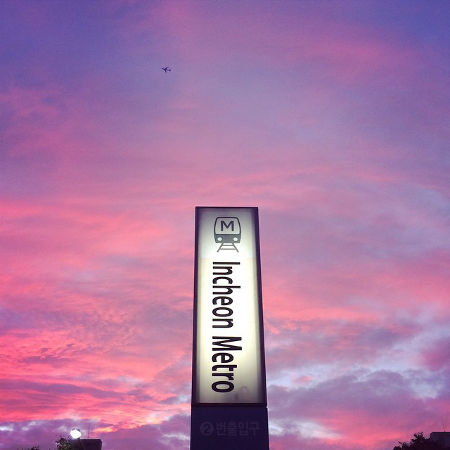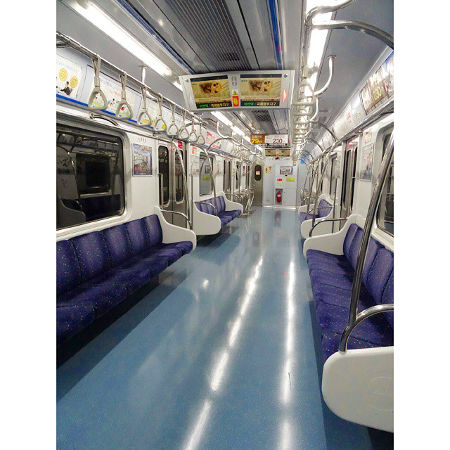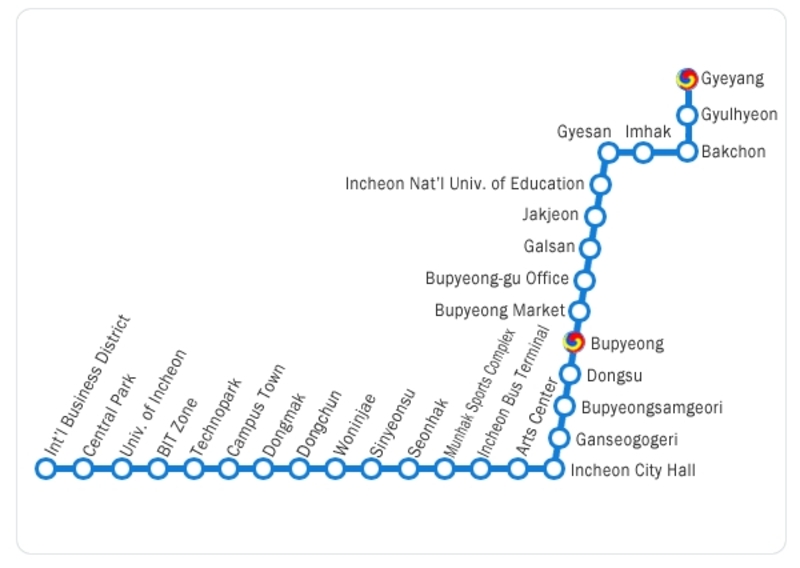The Incheon Metro has two commercial lines: the first one, which has 29 kilometers of length and 29 stations, and the second one, which has 29 kilometers of length and 27 stations.
The Incheon Metro´s business hours are from 5:30 a.m. to 12:00 a.m. all week long.
The Incheon Metro´s fares are dependent on the distance of the journey that the user chooses. Its tickets can also be used on the Seoul Metro, as well as on the bus lines of both municipalities.
Payments tend to be made through the T-money loadable card.
The Incheon Metro has a direct connection with the Incheon International Airport through the railway express line called AREX (Airport Railroad Express.)
Metros in South Korea: Incheon Metro
Incheon is a coastal city located to the northeast of South Korea, bordering at the east with Seoul, the capital of the country, and the municipality of Gyeonggi. Incheon, Seoul, and Gyeonggi comprise the fourth most populated metropolitan area in the world. These three cities are quite connected, as if they were a single city.
Currently, it is the home of 2.9 million people, who tend to commute between their home city and the capital of South Korea.
In that sense, one of the most striking works of this economic growth has been the Incheon Metro since it has had a substantial impact in the life of its residents.
After six years of intense labor during construction work, this system was inaugurated on 1999, becoming the fourth mean of transportation of similar features in the country. The metro was well received by the citizens, who quickly noticed the significant benefits that it would bring to their quality of life.
The Incheon Metro was gradually being integrated to the giant subway network of the Seoul Metro, to the point that it is currently considered part of the latter. However, both metros are operated by different firms, and they are both differentiated on the systems´ maps.
Lines and connections
The Incheon Metro has two commercial lines. The first one was inaugurated on 1999, having 29 kilometers of railroad and 29 stations, while the second one was recently opened, that is, on 2016. Line 2 is also 29 kilometers long, but it only has 27 stations.
 Incheon Metro Wagon
Incheon Metro Wagon
Line 1 (stations):
- Gyeyang (계양): It is located on the Gyeyang-gu district. It has a connection with the AREX express line (Airport Railroad Express).
- Gyulhyeon (귤현): It is located on the Gyeyang-gu district. It does not have any connections.
- Bakchon (박촌): It is located on the Gyeyang-gu district. It does not have any connections.
- Imhak (임학): It is located on the Gyeyang-gu district. It does not have any connections.
- Gyesan (계산): It is located on the Gyeyang-gu district. It does not have any connections.
- Gyeongin National University of Education (경인교대입구): It is located on the Gyeyang-gu district. It does not have any connections.
- Jakjeon (작전): It is located on the Gyeyang-gu district. It does not have any connections.
- Galsan (갈산): It is located on the Bupyeong-gu district. It does not have any connections.
- Bupyeong-gu Office (부평구청): It is located on the Bubyeong-gu district. It has a connection with Line 7 of the Seoul Metro.
- Bupyeong Market (부평시장): It is located on the Bupyeong-gu district. It does not have any connections.
- Bupyeong (부평): It is located on the Bupyeong-gu district. It has a connection with Line 1 of the Seoul Metro.
- Dongsu (동수): It is located on the Bupyeong-gu district. It does not have any connections.
- Bupyeongsamgeori (부평삼거리): It is located on the Bupyeong-gu district. It does not have any connections.
- Ganseogogeori (간석오거리): It is located on the Namdong-gu district. It does not have any connections.
- Incheon City Hall (인천시청역): It is located on the Namdong-gu district. It has a connection with Line 2 of the Incheon Metro.
- Arts Center (예술회관): It is located on the Namdong-gu district. It does not have any connections.
- Incheon Bus Terminal (인천터미널): It is located on the Nam-gu district. It has a connection with the Incheon Bus Terminal.
- Munhak Sports Complex (문학경기장): It is located on the Yeonsu-gu district. It does not have any connections.
- Seonhak (선학): It is located on the Yeonsu-gu district. It does not have any connections.
- Sinyeonsu (신연수): It is located on the Yeonsu-gu district. It does not have any connections.
- Woninjae (원인재): It is located on the Yeonsu-gu district. It has a connection with the Suin Line (Suwon-Incheon.)
- Dongchun (동춘): It is located on the Yeonsu-gu district. It does not have any connections.
- Dongmak (동막): It is located on the Yeonsu-gu district. It does not have any connections.
- Campus Town (캠퍼스타운): It is located on the Yeonsu-gu district. It does not have any connections.
- Technopark (테크노파크): It is located on the Yeonsu-gu district. It does not have any connections.
- BIT Zone (지식정보단지): It is located on the Yeonsu-gu district. It does not have any connections.
- University of Incheon (인천대입구): It is located on the Yeonsu-gu district. It does not have any connections.
- Central Park (센트럴파크): It is located on the Yeonsu-gu district. It does not have any connections.
- International Business District (국제업무지구): It is located on the Yeonsu-gu district. It does not have any connections.
 Incheon Metro
Incheon Metro
Line 2 (Stations)
- Geomdan Oryu (검단오류): It is located on the Seo-gu district. It does not have any connections.
- Wanggil (왕길): It is located on the Seo-gu district. It does not have any connections.
- Geomdan Sageori (검단사거리): It is located on the Seo-gu district. It does not have any connections.
- Majeon (마전): It is located on the Seo-gu district. It does not have any connections.
- Wanjeong (완정): It is located on the Seo-gu district. It does not have any connections.
- Dokjeong (독정): It is located on the Seo-gu district. It does not have any connections.
- Geomam (검암): It is located on the Seo-gu district. It has a connection with the AREX (Airport Railroad Express) express line.
- Geombawi (검바위): It is located on the Seo-gu district. It does not have any connections.
- Asiad Stadium (아시아드경기장): It is located on the Seo-gu district. It does not have any connections.
- Seo-gu Office (서구청): It is located on the Seo-gu district. It does not have any connections.
- Gajeong (가정): It is located on the Seo-gu district. It does not have any connections.
- Gajeong Jungang Market (가정중앙시장): It is located on the Seo-gu district. It does not have any connections.
- Seongnam (석남): It is located on the Seo-gu district. It has a connection with line 7 of the Seoul Metro.
- West Woman's Community Center (서부여성회관): It is located on the Seo-gu district. It does not have any connections.
- Incheon Gajwa (인천가좌): It is located on the Seo-gu district. It does not have any connections.
- Gajaeul (가재울): It is located on the Seo-gu district. It does not have any connections.
- Juan National Industrial Complex (주안국가산단): It is located between the districts of Seo-gu and Nam-gu. It does not have any connections.
- Juan (주안): It is located on the Nam-gu district. It has a connection with line 1 of the Seoul Metro.
- Citizens Park (시민공원): It is located on the Nam-gu district. It does not have any connections.
- Seokbawi Market (석바위시장): It is located on the Nam-gu district. It does not have any connections.
- Incheon City Hall (인천시청): It is located on the Namdong-gu district. It has a connection with line 1 of the Incheon Metro.
- Seokcheon Sageori (석천사거리): It is located on the Namdong-gu district. It does not have any connections.
- Moraenae Market (모래내시장): It is located on the Nam-gu district. It does not have any connections.
- Mansu (만수): It is located on the Nam-gu district. It does not have any connections.
- Namdong-gu Office (남동구청): It is located on the Nam-gu district. It does not have any connections.
- Incheon Grand Park (인천대공원): It is located on the Nam-gu district. It does not have any connections.
- Unyeon (운연): It is located on the Nam-gu district. It does not have any connections.
Schedule
The Incheon Metro has the same schedule that the Seoul Metro, since both are part of the same underground network, so they complement each other. Even though it is not a 24 hour long service like other similar big systems, it does offer convenient business hours, which cover a period of time big enough to satisfy the needs of the daily commuters.
The stations open their doors beginning at 5:30 a.m., which is when the trains depart from their respective terminal stations from each line, and they attend the stops uninterruptedly until midnight. Fifteen minutes before 12:00 a.m., the stations start closing their doors with the purpose of not receiving any more users, and to allow people that are still travelling on the trains to exit around the previously mentioned hour.
Even though the opening and closing times are the same regardless of the day of the week, or whether there is a holiday or not, the waiting times between trains do vary. From Monday to Saturday, the vehicles tend to arrive at the platforms each 8 minutes during a regular working day. However, during peak hours, that waiting time is reduced in half, or in other words, it becomes four minutes. Meanwhile, on Sundays and holidays, the trains transit the stops each 8 or 10 minutes throughout the day.
Fares
The Incheon Metro´s fares are dependent on the distance of the journey that the user chooses. Also, the tickets and access cards are exactly the same as the ones used in the Seoul Metro. Therefore, both of them can be used on both systems, as well as on the bus lines of both municipalities.
The payments tend to be made through the T-money reloadable card, as well as through the mobile app of the same name. The first one can be acquired at authorized stores, kiosks, supermarkets, ticket booths at the stations, and at vending machines. Meanwhile, the app can be installed on most operative systems.
T-money Card (and mobile app)
The T-money card has a cost of 2,500 Won (2.20 USD,) and the different fares and journeys that it offers, are the following:
- Up to 10 kilometers of distance traveled: 1,250 KRW.
- Between 10 and 50 kilometers: 100 KRW for each five kilometers traveled.
- Over 50 kilometers: 100 KRW for each 8 kilometers traveled.
Tickets
The fares for the standard tickets are the following:
- Up to 10 kilometers of distance traveled: 1,350 KRW.
- Between 10 and 50 kilometers: 100 KRW for each five kilometers traveled.
- Over 50 kilometers: 100 KRW for each 8 kilometers traveled.
Students
Students get a discount for their journeys, as long as they have the T-money card, or they use the mobile app.
- Up to 10 kilometers of distance traveled: 720 KRW (T-money).
- Up to 10 kilometers of distance traveled: 1,350 KRW.
- Between 10 and 50 kilometers: 80 KRW for each five kilometers traveled.
- Over 50 kilometers: 80 KRW for each 8 kilometers traveled.
Children
Children between six and 12 years of age have discounts. These discounts apply for both the T-money Card and the standard tickets.
- Up to 10 kilometers of distance traveled: 450 KRW.
- Between 10 and 50 kilometers: 50 KRW for each five kilometers traveled.
- Over 50 kilometers: 50 KRW for each 8 kilometers traveled.
Note: People over 65 years of age, people with disabilities and children under five are entitled to use the Incheon public transportation systems for free.
Rules
- All children over six years of age must pay for their ride, regardless of whether or not they are in the company of their parents.
- As a general rule on the Incheon Metro, your belongings should not obstruct other passengers.
- While the user waits on the platform, you should avoid leaning on the glass barrier that keeps away you from the train´s tracks.
- Smoking is strictly prohibited on the stations and trains of the system.
- You cannot bring objects of flammable nature nor fireworks with you.
- You will not be able to have access to the Incheon Metro´s stations if you are under the influence of alcohol.
- You should avoid running on the system´s stations.
- If bring in a stroller, you will have to fold it before entering the train or, if you can´t do that, you will have to go to the first or last wagon of the train.
- While moving around the Incheon Metro´s facilities, make sure to walk on the right side. This way, passengers will be able to commute faster on the stations.
- Make sure to always keep a respectful attitude towards the service´s personnel and towards the rest of the users. Likewise, always follow the instructions given by the former.
- You should wear headphones anytime that you wish to play multimedia content while traveling on the Incheon Metro.
- You cannot block the system´s doors while they are closing.
- Avoid distracting the service´s personnel on the stations.
- While travelling or waiting at the Incheon Metro´s facilities, you may not beg nor sell any kind of merchandise.
- Consuming alcohol is banned for all users while they wait or ride on the system´s trains.
- The only people that are allowed to carry firearms are police officers with proper identification.
- You cannot hand out flyers, brochures, or any other kind of advertisement materials without the authorization of the authorities of the system.
- You cannot attempt to have access to the areas reserved for metro´s personnel.
- Assaulting in a physical, verbal, or psychological way to any passenger is not allowed within the subway´s facilities.
Connection with the airport
Fortunately, the Incheon Metro has a connection with the Incheon International Airport, through a railway express line called AREX (Airport Railroad Express). You can board the trains of this line at two stations: in Geomam, which belongs to line 2 and it is the closest station to the airport, and at Gyeyang, which is part of line 1 and it is a little farther from the airport. At any of the two stops you will be able to board the AREX vehicles without a problem.
The journey only lasts 30 minutes from Geomam to the airport, while the trip from Gyeyang lasts 37 minutes. Also, the price of the ride varies depending on the station from which you decide to depart. If you take the train at Geomam, you will have to pay 3,200 KRW. Meanwhile, if you decide to take the train at Gyeyang, the price of the ride is 3,700 KRW.
Also, you will be able to disembark at two stops on the airport, which are the Terminal 1 and Terminal 2 stops. Making this journey is quite simple since you will find staff that is authorized to assist you, especially at the stations located at the airport.
On the other hand, if you start your journey on the opposite direction, that is, from the airport to Incheon, and you do not disembark at the Metro Incheon´s stops, you will be able to continue your journey towards Seoul, since that´s where the last station of the journey is located.
You should also the amount of luggage that you bring with you, since loads of excessive size are not allowed on the AREX trains. If you do bring excessive amounts of luggage, you will have to use one of the taxi lines available at the Incheon International Airport´s exits.
Touristic Attractions
Incheon offers many touristic facilities for its residents and visitors, such as Songdo Central Park, which is close to Central Park station from line 1. Said place offers vast green areas, ideal for taking a walk or for riding a bicycle. There are also many sculptures available and a beautiful lake that, alongside the green areas, are within the 41 hectare surface area of the park. This park was inspired by the blueprints of New York´s Central Park since the authorities wanted a higher presence of these kinds of spaces, which were forgotten during the years of industrial growth of Incheon.
Another wonderful facility in the city destined to encourage people to visit green areas is the Incheon Grand Park, which you can reach by disembarking on Incheon Grand Park station, which is on line 2. On its vast spaces, visitors can access a botanic garden with over 300 plant species, a rose garden that hosts 66 kinds of flowers, a zoo for kids, in which 42 types of animals live, and a museum about the environment. It is one of the most visited places in the city due to its huge size and variety of activities, making it a recommended place to visit.
Incheon Subway map
- Also Known As: Subway
- Passengers/Day 200000
- Fares:
- 24h operation: No
- Air Conditioning: No
- Walk between platforms: No
- Driverless trains: No
- Screen Doors Platforms: Yes
- Operator: Incheon Metro
- 4
- Incheon Metro Official Website
- Tlf: +82 1899-4446
Help us
If you consider that the information we provide is wrong, not accurated, outdated, translation contains errors, and you would like to help us to improve the file...you can contact us here.
Feel free to contact us if you dont find the system you're looking for and we'll add it as soon as we can!
Thank you very much!








